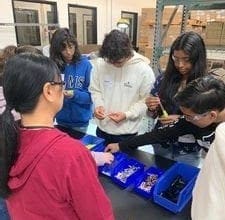New Report Identifies Where Full and Permanent LWCF Funding Will Address Critical Threats to America’s National Parks

With Legislation to Fully Fund LWCF in the Balance, Coalition to Protect America’s National Parks Identifies 2.6m Acres of Private Land in National Parks in Need of Protection
Group Says LWCF Funding is Needed to Protect Areas Within America’s National Parks – Known as Inholdings – At Risk of Development, Could Undermine Resource Protection and Visitor Experience; LWCF Funding Would Help Purchase Inholdings from Private Sellers
WASHINGTON, DC — A new report from the Coalition to Protect America’s National Parks out today shows the concrete need for funding from the Land and Water Conservation Fund (LWCF) to complete our national parks. Congress currently has an opportunity to pass the Great American Outdoors Act and finally provide full, permanent funding for the Land and Water Conservation Fund and address the nearly $12 billion maintenance backlog in our national parks system. The report highlights over 2.6m acres of private land still existing within the boundaries of national parks – which would take an estimated $2 billion to permanently protect.
Known as inholdings, privately-owned land inside the boundaries of national parks, these properties can present serious challenges for resource protection and visitor experience. Inholdings threaten to mar vistas with development, impede recreational access, and damage the parks’ rich natural and historical resources. Managing around inholdings is often difficult. Challenges can include increases to the potential for wildfire danger and the possibility of contamination to streams and waterways. Once these inholdings are developed or subdivided, they are lost forever.
According to the Coalition to Protect America’s National Parks, one of the biggest obstacles to addressing these inholdings is the lack of reliable funding available from the Land and Water Conservation Fund – which the Great American Outdoors Act would address.
The report, America’s Best Idea at Risk, highlights a small subsection of the many opportunities to use funds provided by the Land and Water Conservation Fund to purchase this private land from willing sellers in order to complete national parks and ensure that irreplaceable natural and cultural resources stay protected.
A 2018 National Park Service study found that 318 million park visitors spent an estimated $20.2 billion in local gateway regions while visiting units of the National Park System across the country. These expenditures supported a total of 329 thousand jobs, $13.6 billion in labor income, $23.4 billion in value added, and $40.1 billion in economic output in the national economy.
VIEW THE FULL REPORT HERE: https://protectnps.org/2020/03/11/americas-best-idea-at-risk/
“LWCF is the only source of federal funding to permanently protect the irreplaceable natural and cultural resources that lay within the boundaries of our national parks. From Palo Alto Battlefield National Historical Park to Zion National Park, LWCF funding plays a huge role in preserving our national parks and bringing private inholdings into the National Park system,” explained Phil Francis, chair of the Coalition to Protect America’s National Parks. “We are calling on Congress to pass full, permanent funding for LWCF to ensure that these critical inholidings are not lost forever. LWCF is an investment in our future, but it is an empty promise without the necessary funds to truly protect lands that are at risk.”
- Grand Teton National Park, Wyoming: This iconic park is recognized for its stunning landscape and rich cultural history.
- In 2018, 3.5 million park visitors spent an estimated $629 million in local gateway regions while visiting Grand Teton National Park, supporting 8620 jobs and $792m in economic output.
- In January 2020, with the help of partner organizations, the park was able to acquire a key 35-acre inholding, the third of six high-priority parcels, with LWCF funding. The land, just east of Jackson Hole Mountain Resort’s St. John’s Traverse, was highly threatened by residential development, given the mountain views.
- But there are still 122 tracts of private land, totaling 924 acres, within the boundaries of the park, that remain at risk and a high priority for the NPS to acquire. LWCF funding continues to be needed in order to forever preserve the integrity of Grand Teton National Park.
- Palo Alto Battlefield National Historical Park, Texas: This historic park is the only site in the National Park System to interpret the events of the US-Mexican War, allowing visitors to walk in the footsteps of history.
- In 2018, 82,500 park visitors spent an estimated $4.9m in local gateway regions while visiting the park, supporting 73 local jobs and $6.1m in economic output.
- In 2020, LWCF funding may allow an additional 1354 acres to be protected to improve the visitor experience and protect the park from development.
- But 18 tracts of private land, totaling 1631 acres, remain within the authorized boundaries of the park – putting more than half the park at risk of development.
- Zion National Park, Utah: With its slot canyons and towering walls for rock climbing and hiking, Zion is the third-most visited national park in the country.
- In 2018, 4.3m park visitors spent an estimated $246m in local gateway regions while visiting Zion National Park, supporting more than 4130 local jobs and $327m in economic output.
- In 2018, LWCF funds allowed for the acquisition of a key 35-acre parcel at Firepit Knoll near Zion’s Hop Valley trailhead, ensuring public access to the so-called Trans-Zion trek. And in 2019, the last unprotected mile of the world-famous Zion Narrows Trail was purchased using LWCF funds.
- However, over 3,000 acres of private land inside the boundaries of Zion National Park remain at risk of development.
- Saguaro National Park, Arizona: This unique wilderness protects not only the iconic Saguaro Cacti, but is also home to a diverse Sonoran Desert ecosystem filled with cultural and archeological features and recreational opportunities.
- In 2018, 957,000 park visitors spent an estimated $62.1m million in local gateway regions while visiting the park, supporting a total of 866 jobs and $90.9m in economic output.
- Previously, LWCF funds helped secure over 40 acres of land on the east side of the park, which were critical for the protection of habitat for the desert tortoise, Gila monster and other species.
- However, 56 tracts of private land, totaling 1,007 acres, remain within the boundaries of the park. Without funding from LWCF, these lands are at risk.
- Sleeping Bear Dunes National Lakeshore, Michigan: Home to more than 60 miles of pristine sandy Lake Michigan beaches, massive shoreline sand dunes, forest hills and quiet rivers, this landscape tells the geological history of continental glaciation.
- In 2018, 1.6m park visitors spent an estimated $180m in local gateway regions while visiting the national lakeshore, supporting 2470 jobs and $217m in economic output.
- In the last five years, LWCF funding has opened 400 acres to the public, but 98 tracts of private land remain inside the Lakeshore boundary, totalling more than 2000 acres.
- Chattahoochee River National Recreation Area, Georgia: A vital outdoor recreation destination for runners, hikers, cyclists, birdwatchers, anglers, tubers, kayakers and canoeists – this outdoor space is the backyard of the densely populated city of Atlanta.
- In 2018, 2.9m million park visitors spent an estimated $128m in local gateway regions while visiting the park, supporting 1820 jobs and $179m in economic output.
- LWCF funding is still needed to protect the 21- acre “Deep River Farm” property, on the western bank of the Chattahoochee River. The acquisition of this property would open public access to nearly 1,000 feet of river frontage and enable the National Park Service to expand recreational opportunities at the Bowman’s Island Unit and protect Atlanta’s drinking water.
The Coalition to Protect America’s National Parks is a reliable, respected, and effective advocate for achievement of the mission and goals of the National Park Service. Recognized as the Voices of Experience, the Coalition studies, educates, speaks, and acts for the preservation and protection of the National Park System, and mission-related programs of the National Park Service. The Coalition represents over 1,700 current, former, and retired employees and volunteers of the National Park Service, with over 40,000 collective years of stewardship of America’s most precious natural and cultural resources. More information can be found at https://protectnps.org.




